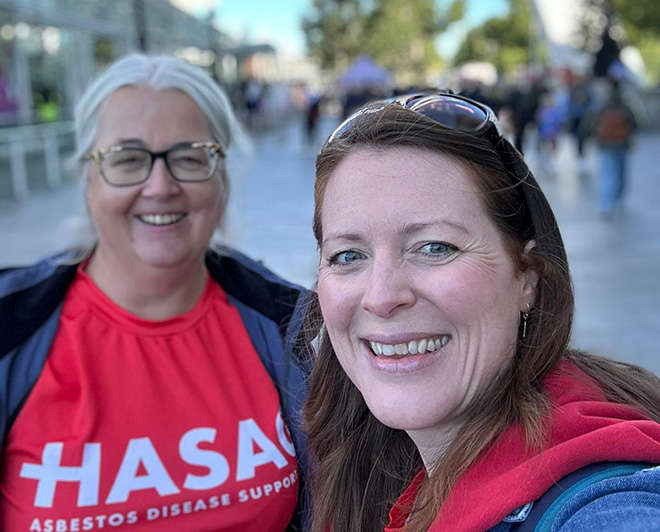Contact our mesothelioma and asbestos claims specialists today.
Call now
SWASAG events

The South West Asbestos Support and Awareness Group (“SWASAG”) provides help and support to asbestos disease sufferers and their families in the region and we are honoured to have been on their legal panel since 2021.
Not only do we attend the group’s monthly support meetings in Truro and Plymouth, providing expert legal advice on potential asbestos disease claims to its members, but also its special events. The highlights that stand out for us this year are the Five Year Anniversary Ball in May, which celebrated five years of SWASAG’s charitable status, and the Johnny Cowling Comedy Night in January, both held at The Alverton Hotel, Truro. The latter is an annual event held in memory of Mike Moncini, father of Julie and Helen who founded the charity and who sadly lost his life to mesothelioma in 2018. This year, the event raised an incredible £4,300 for the charity.
These events are always so much fun, full of music, dancing and laughter and we look forward to supporting more in the future.
MAVSG events
Michael Wolstencroft and David Hughes from RWK Goodman’s asbestos team had the pleasure of attending the 30th birthday party of the Merseyside Asbestos Victims Support Group (MAVSG) in Liverpool in October 2023.
MAVSG is a Merseyside institution and, over the past 30 years, the team have assisted thousands of victims of asbestos-related disease and their families. They have campaigned tirelessly to raise awareness of the dangers posed by asbestos exposure and the risks it still poses to men and women in the Merseyside area and further afield.
It was an honour to attend the 30th birthday party and here’s to continuing the good work for many more years ahead!
HASAG events
HASAG – London Bridges Challenge

On Sunday 15 October 2023, Helen Childs and Annabelle Neilson joined HASAG and friends to trek across eight bridges in London, armed with a quiz to complete on the way. It was a beautiful sunny, cold day and we were soon enjoying the London landmarks. HASAG far exceeded their target and raised £1,335 to help support the wonderful work they do for mesothelioma patients.
HASAG – RHS Hyde Hall
On Tuesday 5 December 2023, Annabelle Neilson was delighted to join HASAG and patients at RHS Hyde Hall in Chelmsford, Essex, for some wellbeing and lifting of spirits ahead of the Christmas period. We were fortunate to have a guided tour of the gardens and then a delicious afternoon tea in the Gardener’s Rest restaurant. The dry garden at Hyde Hall was particularly interesting, as they never water it. Annabelle enjoyed it so much, she even returned for the Glow event later in December.
HASAG – Light up a Life Carol Service

Annabelle Neilson and Rachel Hicks from RWK Goodman thoroughly enjoyed attending the HASAG ‘Light up a Life Carol Service’ at Guy’s Chapel, London, in December 2023.
It was a very moving service with carols sung by a school choir and poignant readings. It was a lovely time to reflect and remember all of our incredible clients and their families who have been affected by asbestos related diseases.
There was an opportunity to write messages to loved ones in baubles to hang on the beautiful Christmas tree in the Chapel.
Thank you HASAG for organising such a special and memorable service.
HASAG Clinician Study Day

Annabelle Neilson and Rachel Hicks had a brilliant day at HASAG’s Clinician Study Day in London on 25 January 2024.
Lynne Squibb from HASAG opened the day with an excellent talk detailing her family’s personal journey with mesothelioma which led to the creation of HASAG. We also heard from Rachel Thomas from HASAG who explained her new nursing role at HASAG and the invaluable work she is able to do to support mesothelioma patients and their families.
Throughout the day we heard from a number of interesting speakers on both medical and legal topics.
David Waller, leading Thoracic Surgeon, presented on the results of the Mars 2 Trial and the role of surgery in mesothelioma. Sam Westbrook, a Peritoneal Mesothelioma Nurse, gave an insight into her role at Basingstoke Hospital and spoke about the fantastic support Zoom meetings she runs. RS Oncology gave a talk regarding the MITOPE trial. Dr Riyaz Shah, Consultant Thoracic Medical Oncologist, spoke on what’s new in mesothelioma and provided an update on non small cell lung cancer. Simon Bolton, a Clinical Nurse Specialist at Mesothelioma UK, gave an excellent talk on ‘scanxiety’ and discussed the findings from the Mesothelioma UK study which were very interesting in demonstrating different views and coping mechanisms on ‘scanxiety’.
We then heard a number of talks from industrial disease solicitors. Annabelle Neilson from RWK Goodman gave an insightful talk into immunotherapy and non NHS funded treatment. Annabelle provided case examples and discussed how RWK Goodman ensure provision for future non NHS funded medical treatment as part of the settlements we secure for our clients.
The day was hugely enjoyable. It was lovely to meet such a wide variety of professionals, to include nurses, doctors, charity representatives and lawyers. Thank you HASAG for organising such an educational and fascinating study day.
Proud winners of Mesothelioma UK’s Christmas carol-off

As a team, we are always proud to support Mesothelioma UK’s efforts to raise funds and awareness. There is always one of their events, however, that makes us laugh and cower in equal measure, and that is the Christmas Carol-off.
This year our team entered the “Best Entertainment and Presence” category with all of us singing at least one line each from “The 12 Days of Christmas”. We won’t forget Nadia’s classic line, “….and a penguin in a pear tree,” Lauren’s wacky reindeer dancing and David’s hen wrestling for quite some time!
Our efforts paid off this year when we were recognised as the winner of our category (joint winners, but winners nonetheless!). It has certainly given us some motivation to come up with something just as fun for this year’s entry – watch this space!
Portsmouth Lung Support Group Quiz

Associates David Hughes and Rachel Hicks hosted the annual Roy Castle Lung Cancer Foundation Support Group Quiz on 6 October 2023 in Portsmouth. A rare sunny day in October and well-attended. We look forward to hosting it again this year.
Contact our mesothelioma and asbestos claims specialists today.
Call now
Business Today: Industrial Disease Lawyers
Business Today showcases the most influential claimant advocates in the field of industrial disease, highlighting lawyers who have exhibited remarkable expertise, tireless advocacy, and an unwavering commitment to their clients. Helen Childs was recently recognised as the top industrial disease lawyer for her “exceptional track record,” “tenacity” and as “a true trailblazer” in the legal community.
Helen commented:
“I am truly honoured to be recognised as the top industrial disease lawyer by Business Today. Alongside our team of dedicated specialist lawyers, I feel truly privileged to help those injured by asbestos, including enabling them to access bespoke medical treatment.”
Chambers and Partners 2024

In the latest edition of Chambers and Partners 2024, our Industrial Disease team achieved new and improved rankings:
- New UK-wide ranking
- A new ranking for Jennifer Seavor, Partner
- New Associate-to-Watch ranking for David Hughes, Associate
Chambers also provided the team with the following reviews:
“RWK Goodman houses a prominent industrial disease department. The team has extensive experience in a variety of asbestos cases and often acts on behalf of victims of asbestos-related disease, their families and dependants. It is best known for handling mesothelioma cases and regularly represents claimants from industrial backgrounds.
They offer an excellent service to clients. They are very efficient and knowledgeable too.”
David Hughes was highlighted for his “judgement” and willingness to “put in the hours to get the best results for the clients.” He is noted to genuinely care and give an outstanding service to them.
Jennifer Seavor was recognised as “a brave solicitor who will take on some challenging cases. She works phenomenally hard to get justice.” Feedback included: “She works hard making sure all the i’s are dotted. She has a huge wealth of knowledge and experience in asbestos and really good instincts. She’s a real pleasure to work with.”
Contact our mesothelioma and asbestos claims specialists today.
Call now
Contact our mesothelioma and asbestos claims specialists today.
Call now
Contact our mesothelioma and asbestos claims specialists today.
Call now
Claims involving Johnson & Johnson
Over the years, a number of product liability claims have been brought against Johnson & Johnson who were the leading worldwide producer of talc. This led to a surge in claims against the company. These claims were vigorously defended despite clear evidence that asbestos fibres were present in their talc-based baby powder. In 2018, Reuters published an article exposing much of Johnson & Johnson’s previously confidential internal documents, including reports that revealed the presence of asbestos in their Johnson & Johnson Baby Powder.
In order to avoid their liabilities and further legal claims, Johnson & Johnson created a company called LTL Management LLC, split their liabilities for talc from the assets of Johnson & Johnson and immediately filed for bankruptcy in light of the rising number of talc claims. Frustratingly, this means that no legal claims can currently be made against Johnson & Johnson in respect of asbestos contamination of their products.
When is it possible to bring a US-based talc claim?
Anyone who contracts mesothelioma needs to be aware that cosmetic products they used may have contained asbestos-contaminated talc. It is sometimes possible for UK victims of mesothelioma, many of whom will be women, to seek compensation from these cosmetic companies in the US.
When assessing whether it is possible to bring a US-based talc claim, we ask our clients several questions, including whether they or their families have previously used powder or make-up products containing talc, including perfumed body powders, face powders or baby powders. We also ask whether they have been to America and whether they have purchased any make-up or talc products there. It is still possible to bring a claim for clients who have never been to America, or purchased powders/make up products from there, but to do so includes detailed analysis, such as whether the talc product was manufactured in New York or whether cosmetic research development centres were present there.
Typically, considering whether or not a talc claim will be possible depends on the client’s use of the talc products, when they used them, and for how long they used them. American talc claims require a deposition from the client by way of oral evidence rather than a written statement, which is different to the UK legal claim process where a client’s written witness statement often forms their evidence. If the mesothelioma sufferer is no longer alive, evidence can sometimes be provided from family members/witnesses about their use of the talc-based products.
Our cases
We have worked closely with a leading US trial attorney on a number of cases involving US product liability lawsuits. These lawsuits on behalf of UK-based victims of mesothelioma can be extremely valuable, in some circumstances in excess of $1,000,000.
In one of our claims, evidence was provided by the family of a lady who sadly passed away from mesothelioma. This lady was exposed to asbestos-contaminated talc through her use of Avon, Elizabeth Arden and Clinique powders from the 1970s to the 1990s. Photographs of the cosmetic products used have been helpful in supporting the claim. The claim is currently ongoing.
Many mesothelioma claims arise from exposure to asbestos in the workplace. Typically, exposure to asbestos has caused mesothelioma for a variety of tradesmen who have worked with asbestos products in industrial settings. Asbestos talc claims are very different. It is alarming to think that the talc-based powders and cosmetic products we have all used over the years have been found, in some instances, to be heavily contaminated with asbestos which can lead to the development of mesothelioma. It is very important that the possibility of exposure to talc-based powders and cosmetics is fully considered when considering legal redress for mesothelioma.
Contact our mesothelioma and asbestos claims specialists today.
Call now
Is there a right to a second opinion and how easy is it to change solicitor?
Everyone has the right to a second opinion, not least because different law firms may take different views on a case. Some may be willing to take on cases that do not meet other firms’ selection criteria. No solicitor is compelled to take on an individual case, therefore it is always worth having your case reviewed by other firms to see if their opinion differs.
Mr J had been advised by a national law firm in his lifetime and had had his case turned down because that firm felt the prospects of success were insufficient. Mrs J approached us at RWK Goodman for a second opinion, and upon reviewing the case, there was further evidence that could be gathered from other witnesses and other possible angles that could be investigated. Mrs J brought a case on behalf of the Estate of Mr J and it was concluded successfully, despite Mr J being advised by another firm that they could not continue to act due to the case having insufficient prospects of success.
What about the costs?
In the case of Mrs J, her case had been turned down by a previous firm, so she was able to enter into a new Conditional Fee Agreement with us without having to pay any of her previous solicitor’s costs.
Mrs B, Executrix of the Estate of Mr B, also found her claim being turned down by a national law firm, but her claim succeeded when she instructed us. The evidence was approached from a different angle and the case brought on the basis of the Occupiers Liability Act instead of an Employer’s Liability claim. Mrs B did not have to pay any additional costs and was able to enter into a new Conditional Fee Agreement with us.
The same thing occurred in the case of Lloyd v Humphreys & Glasgow [2015], which succeeded at trial after Mrs Lloyd instructed us after two previous firms had been unable to pursue her case. Our detailed understanding of out-of-time cases and the impact on Mr Lloyd’s claim of the asbestos trigger litigation meant that, when we assessed the merits of the claim, we thought it had good prospects.
What if I want to change solicitors because I am unhappy with my solicitor?
If a claimant is unhappy with their solicitor, can they change firms? Whilst a solicitor can charge their client for terminating the CFA, solicitors have to abide by the terms and conditions of the CFA agreements in the same way that their clients do. If they have not provided timely advice or advice on the pros and cons of legal action, then they may be in breach of the agreement. In practice, solicitors will normally make an arrangement with each other to preserve and recover the costs of the claim on behalf of the original solicitor, meaning that changing solicitors is a viable and usually straight forward process.
If the claimant is unhappy with the progress of their claim, there can be benefits in approaching another lawyer. Asbestos claims are technically difficult. The Mesothelioma List in London’s Royal Courts of Justice has a special fast track procedure outside of the normal procedure for injury claims. A specialist solicitor will know how to navigate these promptly and efficiently, to progress cases urgently.
In the case of Mr H, he instructed a small regional law firm that did not specialise in asbestos claims. He had a very strong claim and was in desperate need of an interim payment to fund private immunotherapy treatment, as at that point his treatment was not available on the NHS. Mr H’s solicitor was not progressing his case rapidly, despite the strong prospects and Mr H had to pay for his treatment himself. He was only able to manage this for a short period of time. He sought a second opinion from RWK Goodman and we were able to immediately issue Court proceedings and seek an urgent interim payment, which allowed Mr H to continue with his private medical treatment and recover the cost of what he had already paid.
While there are definite benefits to seeking a second opinion or changing solicitors to a specialist if you feel your claim is not being progressed fast enough, one also needs to bear in mind the practicalities. Files of papers take time to access, and solicitors need time to review and familiarise themselves with the papers. It is essential that practicalities such as limitation dates are kept in mind. As much as a new solicitor may want to help, unless sufficient time is allowed, it may be impossible to achieve. So if you are considering seeking a second opinion, the sooner the better!
Contact our mesothelioma and asbestos claims specialists today.
Call now
Contact our mesothelioma and asbestos claims specialists today.
Call now
We need to talk about death
A book I have been reading recently has introduced me to the concept of an end-of-life, or death, doula. End-of-life doulas provide support for those people who have a terminal illness, whether that is practical, emotional, or spiritual support. This is not something I had ever considered before, but this is probably no surprise, as death is not something that we ever really talk about beyond the practical side of what happens after we die.
As lawyers we are aware of the importance of getting your affairs in order; making sure you have a Will and that financial arrangements are in place to support your loved ones after you die. As a parent, I want to ensure that if I die my children will have appropriate guardians in place and the financial means to support them through to adulthood.
But what about how I die? This is not something that I, or many others, think about, let alone discuss. But many palliative care experts consider that talking about dying and death can help to ensure that everyone gets the support they need, that suits them. There is no one-size-fits-all in death.
For some of us, we will have no warnings about our impending death, although that should not prevent us from being open and frank in talking about it. Dying Matters Awareness Week is 6 to 12 May 2024. It is a movement to encourage us to talk about death, dying and grief.
But what about those who are diagnosed with a terminal condition, such as mesothelioma, who have a prognosis regarding their death. Hospice UK consider that “Honest, timely conversations about death and dying are essential to good end of life care”. So, how can they use this knowledge to plan their death? Can they choose when they die?
Euthanasia: the law
Euthanasia is the “act of deliberately ending a person’s life to relieve suffering”. It is distinguished from assisted suicide, which is assisting another person to kill themselves.
Both euthanasia and assisted suicide are illegal in England, with maximum penalties of 14 years imprisonment for assisted suicide, and life for euthanasia. Assisted suicide prosecutions can also extend to cover those who travel with loved ones abroad to places such as Dignitas in Switzerland.
Despite this, one campaigning group, Dignity in Dying, say that 300 dying people end their own lives in this country every year. Another 350 Britons have also travelled to Dignitas to end their life there. So, is there a need for legislation in England to change? Should we be allowed to choose how and when we die?
Dignity in Dying
Dignity in Dying is an organisation who are campaigning for what they say is a choice, access, and control over how, where, and when we die. But assisted dying is not something which they say should be available to everyone. They are focused only on those with a terminal illness, with six months or less to live.
Dignity in Dying propose a similar law to that in Oregon and other US states, which requires the dying person to end their own life (not another person doing it for them), assessment by doctors and a High Court judge, and which allows the dying person to die at home.
Their position is that it should be dying people who are in control of their deaths, not doctors. They focus on freedom of choice and having a safe, comfortable, and dignified death.
Care not Killing
Conversely, Care not Killing is an organisation opposing euthanasia and instead promoting care. They want to work to promote better and more available palliative care and prevent any relaxing in the law surrounding assisted dying.
They want to ensure that those who are terminally ill do not feel like a burden to loved ones or the healthcare system and believe that, with appropriate palliative care, everyone can have a dignified and peaceful death.
Care not Killing highlight that if a law like that in Oregon was to be introduced in England, we would be looking at around 2,600 deaths per year. Alternatively, using the Netherlands model we would be looking at 13,000 deaths. It is clear therefore that any such legislation could have a significant impact.
Assisted Dying Bill
The call for assisted dying has been given additional weight recently after broadcaster, Esther Rantzen, revealed that she had signed up to Dignitas after her lung cancer progressed to stage 4. A petition was then signed by over 100,000 people calling for the Government to allocate Parliamentary time to debate assisted dying.
On 22 February 2024 the Ministry of Justice responded:
“The Government has the utmost sympathy for anyone experiencing the pain of watching a loved one deal with a life-threatening or degenerative condition.
Whether there are any circumstances in which it should not be an offence to assist another person to die is something on which there are passionately held but deeply divided views. Even amongst those who support a change in the law, there are differing ideas on where the line should be drawn, what safeguards should be in place and for whom. Conversely, others feel strongly that the law should not be changed and that safeguards will not necessarily give enough protection to vulnerable people who may feel pressure, whether real or perceived, to end their own lives.
It remains the Government’s view that any change to the law in this sensitive area is a matter for Parliament to decide and an issue of conscience for individual parliamentarians rather than one for government policy. Parliament has debated this issue on several occasions, most recently in July 2022, but has so far voted against proposals to legalise assisted dying.”
Dignitas
In the meantime, whilst the law in England remains static, many are continuing to choose to travel abroad to end their own life. One such example is Bob Cole who was diagnosed with mesothelioma.
Bob was a campaigner for Dignity in Dying after his wife, Ann, died at Dignitas in Switzerland following a diagnosis of progressive supranuclear palsy, a rare and fatal neurological disease. Bob said in an interview before his death, that Ann’s death was peaceful, quiet, and dignified. After his diagnosis, Bob began to suffer with increasing pain from his mesothelioma and wanted to be able to choose the same death for himself.
Bob also chose to die at Dignitas in Switzerland, a choice not necessarily available to everyone due to the significant cost involved, and the fact that you must be fit enough to travel there. Another consideration is that potentially you must travel on your own, as any loved ones who travel with you risk being prosecuted for the offence of assisted suicide on their return to England.
Planning to die
It certainly cannot be denied that the category of people who will be most impacted by any assisted dying legislation are some of the most vulnerable members of our society, and therefore there is strong opinion on both sides.
But do we need assisted dying to have a dignified death?
I think we can all agree that, wherever possible, we would like to die in comfort, with dignity, and to be psychologically, practically, and spiritually prepared for death.
In the UK we have seen growth of end of life and palliative care services over the past 50 years. There has been more emphasis on suitable end-of-life care and achieving the best possible quality of life for patients. This is reflected in where people are choosing to die, with a greater number of people now dying at home rather than in hospital.
Hospices are invaluable in providing guidance and support in many aspects of end-of-life care including pain relief, symptom control, respite, practical and emotional care. They take a holistic approach to end-of-life care and are generally more comforting and homely environments than hospitals. But hospices are not available to all dying people as they are massively underfunded. Hospice UK reported in September 2023 that adult hospices have “faced a real-terms cut in their government funding of £47m in the past two years”. They are invaluable to our health care system and end-of-life care and yet remain largely charitably funded.
As individuals, we can have more say than ever before in what our death looks like. Hospice UK’s website even offers a planning ahead tool, highlighting different aspects that you may wish to consider when you plan how you will die.
Yet, in the UK, we have not yet gone as far as other countries in allowing those with life-limiting conditions to choose how and when to die. The debate surrounding this issue remains hotly contested and it remains to be seen if this issue will once again come before MPs for further debate.
What is clear is that discussion around death and dying needs to become a less taboo topic, and one we can all feel confident to discuss, and that further investment into palliative end-of-life care is needed.
Contact our mesothelioma and asbestos claims specialists today.
Call now
Mesothelioma treatments
Mesothelioma is a cancer that usually develops in the lining of the lung. The UK has the highest prevalence of mesothelioma cases in the world, with approximately 2,700 people diagnosed with the cancer each year. Mesothelioma is almost always linked to asbestos exposure.
As specialist asbestos disease lawyers, we are all too familiar with the heartbreak, pain and suffering mesothelioma causes for patients and their families. There is no known cure for mesothelioma, but the treatments to improve quality of life and extend life have improved dramatically over the last five to ten years and are continuing to develop at a pace.
Current treatment options and trials
-
Chemotherapy
Chemotherapy uses anti-cancer (cytotoxic) drugs to destroy cancer cells. The drugs circulate throughout the body in the bloodstream and target the mesothelioma cells.
Chemotherapy is available on the NHS.
-
Immunotherapy
In July 2022, NICE approved dual agent immunotherapy as a first line of treatment on the NHS.
Immunotherapy uses the immune system to recognise and kill cancer cells. It is offered to most patients with mesothelioma, dependent on previous treatments that the patient has undergone.
Immunotherapy was called a breakthrough treatment when it was first trialled, and deemed to be more effective than chemotherapy. The clinical trials showed 8% more people surviving with mesothelioma after three years, with a further 13% showing their cancer had stopped progressing in the same time period compared to those treated with just chemotherapy.
-
MARS-2 trial – Pleurectomy decortication surgery
The Mesothelioma and Radical Surgery Trial 2 (MARS-2) was a trial focussed on the effectiveness of surgery.
The study compared the survival of two groups of pleural mesothelioma patients. One group had chemotherapy with the pleurectomy decortication surgery, and the other group had just chemotherapy with no surgery.
Pleurectomy decortication is a two-phase operation. The pleurectomy removes the pleura (the lining around the lung) and the decortication removes the tumorous fibrous tissue from the surface of the lung. The surgery is designed to remove the cancer, whilst preserving the lung itself.
The results from the MARS-2 trial were mixed, with the overall conclusion being that there was no significant difference in survival time between those who had surgery and chemotherapy, and those who just had chemotherapy.
In reality, surgery for mesothelioma is often complicated and risky, but for some it has been successful in stopping disease progression and extending their life expectancy.
-
Proton beam therapy
Proton beam therapy is a type of radiotherapy that uses a beam of high energy protons to target cancer cells. The proton beams are small and therefore this type of treatment allows a dose of high energy protons to precisely target the cancer cells, reducing the damage done to surrounding healthy tissue.
Proton beam therapy is available on the NHS for some cancers, but it is not currently available for mesothelioma. However, patients have successfully sought the treatment privately.
The ATOMIC-Meso Trial
Due to the aggressive nature of mesothelioma, treatment options are limited.
However, on 15 February 2024, headlines broke about a new “breakthrough treatment” for patients diagnosed with mesothelioma, following results released from the ATOMIC-Meso trial.
This trial was run by Professor Szlosarek who some 20 years ago discovered that mesothelioma cells lack a protein called ASS1, which means mesothelioma cells are not able to make an amino acid called arginine. Mesothelioma cells take arginine from the rest of the body and use it to grow.
Over the past two decades, Professor Szlosarek has developed a drug that depletes the arginine levels in the bloodstream. Reducing the levels of arginine in the bloodstream cuts off the supply of arginine to the mesothelioma cells, which cannot develop their own, and in turn thwarts the growth of these cancerous cells.
This drug is known as ADI-PEG20, or pegargiminase, and the impact of the drug was tested in the ATOMIC-Meso trial across five countries from 2017 to 2021, with data analysis performed from March 2018 to June 2023.
This is what happened in the trial:
249 patients with pleural mesothelioma, averaging 70 years of age, took part in the trial. All 249 patients were given a combination of pemetrexed chemotherapy and either cisplatin or carboplatin chemotherapy every three weeks for up to six cycles. 125 of these patients also received additional weekly doses of pegargiminase, with the other 124 patients receiving additional weekly doses of a placebo drug.
The findings from the trial concluded that patients who received the new drug, combined with chemotherapy, had a median overall survival of 9.3 months. This was compared to those who received just chemotherapy and the placebo drug who had a median overall survival of 7.7 months. In addition, four times the number of patients treated with pegargiminase and chemotherapy survived to 36 months compared to those treated with the placebo drug and chemotherapy.
Although to some a median survival of an additional 1.6 months may seem low and inconsequential, it must be remembered that this is a significant amount of time for someone diagnosed with this incurable disease. It is also a significant breakthrough for mesothelioma treatment, with pegargiminase being the first drug of its kind to be successfully combined with chemotherapy in over 20 years.
One patient involved in the trial spoke to the Guardian and Cancer Research and said that he had previously been given a life expectancy of four months. Having received the new drug in the trial, he is still alive now, five years after his diagnosis.
In addition, the ATOMIC-Meso trial reports that the drug has no new known side effects and that side effects were similar between patients given pegargiminase and chemotherapy and patients given just chemotherapy and the placebo drug. In fact, the commonly reported side effects for those receiving pegargiminase with the chemotherapy were nausea, fatigue and constipation compared to those receiving just the chemotherapy who also reported nausea and fatigue, but also anorexia. This suggest that patients given pegargiminase with chemotherapy lost less weight than patients who received just chemotherapy.
Whilst this trial is certainly positive, it is pertinent to note that this trial was focussed on non-epithelioid pleural mesotheliomas and it is not yet known if this drug would be offered to patients diagnosed with epithelioid mesothelioma, or with non-pleural mesothelioma.
Simon Bolton, a mesothelioma clinical nurse specialist, spoke to us and said,
“It’s great to see mesothelioma trials with positive results as it gives our oncologists more ammunition with which to fight this disease. I’m interested to learn where the drug will fit into treatment pathways now we have first line access to immunotherapy. I hope the encouraging trial data from ATOMIC leads to the drug being made available soon to all via the NHS”.
The future
It is hoped this drug will be available as a standard treatment option for patients diagnosed with mesothelioma in the near future. The discovery of this drug is also beneficial to patients diagnosed with other cancers with poor survival outcomes, where those cancer cells are also dependent on arginine.
Above all, this drug provides a viable successful further treatment option, and it gives hope to people diagnosed with mesothelioma and their loved ones.
There is always uncertainty about when and whether new drugs like pegargiminase will be approved by NICE for use within the NHS. In the meantime, those diagnosed with mesothelioma should be encouraged to seek legal advice as it is often possible to access bespoke medical treatment (including drugs like pegargiminase) as part of a claim for compensation.
Contact our mesothelioma and asbestos claims specialists today.
Call now
The problem
You’d be forgiven for thinking that the threat posed by asbestos is a thing of the past in the UK. After all, the use, supply and import of asbestos was banned 25 years ago. However, this misconception assumes that asbestos in buildings built before this time has been entirely removed. Alarmingly, this is not the case.
Some sources estimate that over 1.5 million buildings in the UK contain asbestos, with a large proportion – as many as 400,000, according to the Health and Safety Executive – being public buildings, including schools, hospitals, office spaces or community centres. The asbestos might be present in the form of pipe insulation, internal walls, ceiling tiles or flooring. Whilst it might be considered a low risk to health if properly managed, the fact is that incidents of asbestos exposure in these buildings are still happening today. This might be due to ignorance of the dangers of asbestos and/or the legal duties imposed on the owners of these buildings or knowingly cutting corners to save costs. These buildings are also degrading over time meaning that there is a real risk of asbestos dust being released simply through general wear and tear.
More than 5,000 people die from asbestos-related diseases every year in the UK. Can we reasonably hope to see an end to these deaths whilst our public buildings contain asbestos on such a large scale?
We have brought many successful claims against local authorities and the Government for former teachers, nurses and students who have contracted mesothelioma from asbestos exposure in a school or hospital setting. My view is that the risk of exposure to asbestos remains if action is not taken to tackle the problem of asbestos in public buildings by having it removed once and for all.
Government’s response to the Work and Pensions Committee report, April 2022
In April 2022, the Work and Pensions Committee published their report, “The Health and Safety Executive’s Approach to Asbestos Management” within which it recommended that a 40-year target be set for the removal of all asbestos from public buildings. In the report, the Chair, Rt Hon Sir Stephen Timms MP, described asbestos as “the great workplace tragedy of our time”.
Unfortunately, the Government’s response to the above recommendation was to accept the Health & Safety Executive’s evidence that the Control of Asbestos Regulations 2012 effectively managed the risks of asbestos exposure and will eventually lead to the elimination of asbestos from the built environment without the need for a target deadline. It added that it “could only advocate a proactive course of action in this area if there is compelling evidence that the undoubted increase in exposure to asbestos workers that will result from active removal… is justified in terms of reducing risk of exposure to building users” adding that “at present, this evidence is not there.” The Government commented further that a fixed deadline for the removal of asbestos in public buildings would cause significant disruption to their use and risk poor removal and disposal practices.
Whilst there will be some unavoidable disruption of the use of public buildings if the Committee’s recommendations are implemented, that does not necessarily mean the risk of asbestos exposure to those who would carry out the asbestos removal work outweighs the present risk to the public. Unless there is a dramatic watering down of asbestos removal legislation, the asbestos removal work will be undertaken by specialists taking all the proper precautions, therefore with very limited risk to their health and that of the public. Unfortunately, it cannot be said that the same precautions are being taken by the unassuming public who use these buildings day in, day out – especially as asbestos is not always being properly managed, and the risks of asbestos exposure not always being properly controlled (whether knowingly or not) in public buildings despite the regulations that are in force. This is surely putting the public at greater risk right now compared to any small potential risk to those removing the asbestos.
Furthermore, the Government did not give any reason as to why it believes a phased asbestos removal plan (over a prolonged period of 40 years) will result in an increase of poor removal and disposal practices. Indeed, the Government appeared to have overlooked the comparable risk of shortcuts being taken and accidents happening when it comes to ongoing asbestos management for as long as the asbestos remains present.
Mesothelioma UK’s “Don’t Let the Dust Settle” campaign, April 2023
The Government’s rejection of the Committee’s proposals was certainly a blow to the campaign to see all asbestos removed from public buildings, but momentum gathered regardless after 3 April 2023 when Mesothelioma UK launched its “Don’t Let the Dust Settle: Calling Time on Asbestos” campaign.
Mesothelioma UK is calling for a central register detailing where asbestos is and its condition and is asking the Government to set a timeframe for the safe removal of asbestos from public buildings, prioritising schools and hospitals over the next 40 years.
The Sunday Times launched their “Act Now on Asbestos” campaign in July 2023. Indeed, several charities, MPs, asbestos removal firms and law firms, including RWK Goodman, have helped this campaign build momentum like never before over the past few months.
A parliamentary petition calling for the Government to commit to the recommendations of the Work and Pensions Committee report of 2022 was opened last year to tie in with the above campaigns and attracted over 10,000 signatures, prompting a response from the Government.
The Government commented that it needs “… clear evidence to demonstrate how responding to the two recommendations would improve health outcomes”, adding that “we will continue to consider how we can improve the system to minimise the risk of exposure to asbestos.” The Government voiced the same argument made in its direct response to the Work and Pensions Committee report (above) regarding the current effectiveness of the Control of Asbestos Regulations 2012 in providing a “comprehensive plan to manage asbestos risk.”
I would argue that the Government is, again, missing the point here. Yes, the Control of Asbestos Regulations 2012 do outline a comprehensive asbestos management plan, but are they always being followed? Is, for example, information about the location, condition and type of asbestos in buildings always made available to anyone liable to disturb it or are corners being cut whether inadvertently or to save costs? Moreover, can we safely assume that all users of public buildings are alive to the true dangers of asbestos? Do they even know that asbestos might be around them in these buildings? Would they know not to disturb it? Even if they do, there is the ongoing risk posed from the daily wear and tear of asbestos in the buildings around them. Not to mention that asbestos was often used in conjunction with RAAC, much of which is now well beyond its intended lifespan.
Unfortunately, it looks as though this debate will rumble on for some time to come with the apparent age-old battle between financial resources and people’s health; a battle that for decades has unfortunately always tended to weigh in favour of the former.
However, is it right to assume that implementing the Committee’s recommendations will hit the public purse harder than continuing the status quo?
Mesothelioma UK’s “Cleaning the Air” Report, December 2023
Mesothelioma UK’s “Cleaning the Air” report, published in December 2023, performs a costs/benefits analysis of the removal of asbestos from UK schools and hospitals. It compares the costs involved with the current rebuilding programme for schools and hospitals (resulting in the complete removal of asbestos from these buildings) with the costs involved with a proposed “Rapid Removal Programme” of removing asbestos over a 10-year period. The findings are that, over a 50-year time period, the Rapid Removal Programme would save the UK economy around £11.6 billion in reduced economic and social costs compared to the current removal programme. It estimated that savings to public finances would be in the sum of £3.6 billion.
The question is whether the Government will invest now to solve the problem of asbestos in public buildings to save significant additional costs in years to come. My hope is that they will do the right thing and that the tide will finally turn to prevent yet more lives being lost – completely avoidably – to asbestos-related illness.
Contact our mesothelioma and asbestos claims specialists today.
Call now
Contact our mesothelioma and asbestos claims specialists today.
Call now






